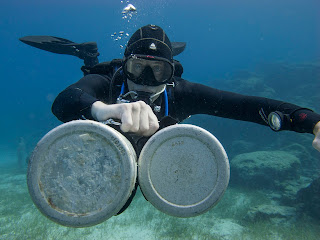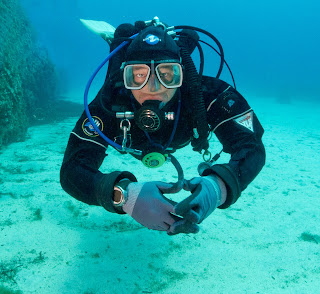
Recreational Divers are regular scuba divers who are qualified with a diving agency such as PADI,
BSAC or CMAS. Their depth limit for diving is usually 40m and they usually dive with just a single cylinder and complete their dives within the no-stop limits offered by recreational dive planners or dive computers. If necessary, the dive can be ended at any point with a direct ascent to the surface without an excessive risk of DCI.
The vast bulk of divers fall into this category.
Technical Divers however, use more complex diving equipment. They may dive a twinset or Sidemount configuration and they are trained to use it properly.
Tech divers have the training, equipment and skills to dive beyond 40 metres and often make decompression dives, which means they cannot make a direct ascent to the surface.
If you exceed your no-decompression, no-stop times, the decompression stop is mandatory and if you miss it, you will put yourself at an unacceptable risk of DCI.
However, just diving beyond 40m and going beyond the no-stop limits to make decopression dives does not make you a tech diver.
Technical divers learn how to use more sophisticated dive gear so, in the event of an emergency when a direct ascent to the surface is not possible due to overhead environments or decompression obligations, they can try to solve the problem underwater to allow them to ascend safely.
For example, a second stage free flows underwater and you are losing gas. In recreational gear, you would swap to your dive buddy's alternate air source and make a direct ascent but tech divers, whether on sidemount or twins, can shut the offending cylinder down and breathe from the other one while they complete decompression obligations or reach a safe depth to breathe a richer, decompression mix.
Mixed gases are another mark of a technical diver.
Nitrox is pretty standard as a breathing gas these days and in and of itself, does not distinguish a tech divers. Most recreational agencies only qualify divers to use up to 40% nitrox.
Tech divers can use up to 100% Oxygen to allow them to optimise off-gassing of Nitrogen (or indeed Helium). If diving to 45m, they could breathe a 25% nitrox mix on the bottom (or a 25/20 trimix), switching to 50% at 20m and then to 100% at 6m. This is known as Accelerated Decompression.

Over the years, the lines between rec and tech have been blurring. Some agencies such as BSAC and
CMAS train their divers to make decompression dives and to dive to 50m using air. Many recreational divers now carry additional cylinders in the form of a pony cylinder or a stage to allow them additional safety options. Sidemount diving and Twinset diving is becoming more mainstream in the recreational market for those wishing to dive with extra gas and nitrox is readily available practically anywhere in the world.
There is even talk of offering rebreather training from the very first dive. That would mean no open circuit training at all. I think that would be a bit further into the future but who knows with the way technology and diving is advancing...
...now where did I put the keys to my hovercraft?




